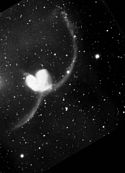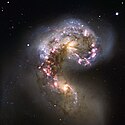Tykadla (galaxie)
| Galaxie Tykadla: NGC 4038 a NGC 4039 | |
|---|---|
(c) ESA/Hubble, CC BY 4.0 Interagující galaxie NGC 4038 a NGC 4039 na snímku z Hubbleova vesmírného dalekohledu. Autor: HST/NASA. | |
| Pozorovací údaje (Ekvinokcium J2000,0) | |
| Typ | spirální galaxie SB(s)m pec / SA(s)m pec[1] |
| Objevitel | William Herschel[2] |
| Datum objevu | 1785[2] |
| Rektascenze | 12h 01m 53s / 12h 01m 53,5s[1] |
| Deklinace | -18°52′03″ / -18°53′10″[1] |
| Souhvězdí | Havran |
| Zdánlivá magnituda (V) | 10,5 / 10,7[2] |
| Úhlová velikost | 5,2' x 3,1' / 3,1' x 1,6'[1] |
| Vzdálenost | 69,6 ± 13,3 Mly / (21,3 ± 4,1 Mpc)[1] |
| Plošná jasnost | 13,3 / 12,2[2] |
| Rudý posuv | 0,005 477[1] |
| Označení v katalozích | |
| IRAS | IRAS F11593-1836 a IRAS 11593-1835 |
| Atlas of Peculiar Galaxies | APG 244 |
| Jiná označení | Antennae Galaxies, NGC 4038 / 4039, PGC 37967 / 37969, Arp 244[1], Caldwell 60/61 |
| (V) – měření provedena ve viditelném světle | |
| Některá data mohou pocházet z datové položky. | |
Galaxie Tykadla (také známé jako Arp 224, NGC 4038/NGC 4039, Galaxie Antény nebo Caldwell 60/61) jsou dvojice interagujících galaxií v souhvězdí Havrana vzdálená přibližně 70 milionů světelných let. Objevil ji britský astronom William Herschel 7. února 1785.[3] V současnosti prochází obdobím prudké tvorby hvězd, která je způsobena srážkami mračen plynů a prachu v propletených magnetických polích. Galaxie jsou v atlasu pekuliárních galaxií označeny jako Arp 244.
Pozorování
Na obloze se nachází v západní části souhvězdí u hranice se souhvězdím Poháru, 0,75 stupně severně od hvězdy 31 Crateris a 3,25 stupně jihozápadně od hvězdy Gienah (γ Crv).[4] Můžeme je vidět středně velkým amatérským astronomickým dalekohledem jako drobnou mlhavou skvrnku ve tvaru srdce. 40 úhlových minut jihozápadně od NGC 4038 se nachází galaxie NGC 4027. Větší dalekohled ukáže další podrobnosti, ale tykadla jsou tak slabá, že nejsou viditelná.[5]
Popis
Galaxie Tykadla prochází galaktickou srážkou. V důsledku této srážky vznikly dva dlouhé slapové ohony, které vypadají jako hmyzí tykadla (anglicky antennae) a jsou tvořeny z galaxií vyvrženými hvězdami, plyny a prachem. Jádra těchto dvou galaxií se spojují a vznikne z nich jedna velká galaxie. Většina galaxií pravděpodobně projde ve svém životě přinejmenším jednou významnou srážkou. Toto asi v budoucnu čeká i naši Mléčnou dráhu, když se srazí s Galaxií v Andromedě.
NGC 4038 je nejvýznamnější člen Skupiny galaxií NGC 4038, která leží ve vzdálenosti 70 milionů světelných let a kam patří i NGC 4039, NGC 3957, NGC 3981, NGC 4027 a několik dalších galaxií.[6]
Supernovy
V galaxii NGC 4038 zatím bylo pozorováno pět supernov: SN 1921A, SN 1974E, SN 2004GT, SN 2007sr (typ Ia, magnituda 12,9) a SN 2013dk.[7]
Vývoj
Před 1,2 miliardami let byla Tykadla oddělené galaxie. Spirální galaxie NGC 4039 byla větší než spirální galaxie s příčkou NGC 4038. Před 900 miliony let vypadala Tykadla podobně jako NGC 2207 a IC 2163. Před 600 miliony let se galaxie minuly a vypadaly jako NGC 4676 (galaxie Myši). Před 300 miliony let začaly z galaxií vystupovat dva proudy hvězd, které dnes zasahují daleko za hranice původních galaxií a vypadají jako tykadla.
Během 400 milionů let splynou jádra těchto galaxií do jediného jádra obklopeného hvězdami, prachem a plyny. Pozorování a simulace interagujících galaxií naznačují, že se Tykadla nakonec stanou eliptickou galaxií.[8]
Rentgenová observatoř Chandra objevila při rozboru galaxií Tykadel oblasti obsahující velké množství neonu, hořčíku a křemíku. Tyto prvky jsou nezbytné pro planety, na kterých by mohl vzniknout život. Pozorované oblasti obsahovaly 16 krát více hořčíku a 24 krát více křemíku než Slunce.
Galerie obrázků
Pohled na Tykadla teleskopem VLT na observatoři ESO.
Související články
- Vírová galaxie - velmi známá interagující galaxie.
Reference
V tomto článku byl použit překlad textu z článku Antennae Galaxies na anglické Wikipedii.
- ↑ a b c d e f g NASA/IPAC Extragalactic Database: Results for NGC 4038/NGC 4039 [online]. [cit. 2016-04-08]. Dostupné online. (anglicky)
- ↑ a b c d The NGC/IC Project: Results for NGC 4038 a NGC 4039 [online]. [cit. 2016-04-08]. Dostupné v archivu pořízeném dne 2009-05-28. (anglicky)
- ↑ SEDS NGC Catalog Online: Results for NGC 4038 [online]. [cit. 2016-09-21]. Dostupné online. (anglicky)
- ↑ Stephen James O'Meara. The Caldwell Objects. [s.l.]: Cambridge University Press, 2002. ISBN 978-0-521-82796-6. S. 240–243.
- ↑ Michal Kodriš. Průvodce hvězdnou oblohou: Střelec [online]. [cit. 2016-04-05]. Dostupné online.
- ↑ Richard Powell. Atlas of the Universe: A List of Nearby Galaxy Groups [online]. [cit. 2016-04-11]. Dostupné online. (anglicky)
- ↑ List of Supernovae [online]. Harvard-Smithsonian Center for Astrophysics (IAU) [cit. 2016-04-11]. Dostupné online. (anglicky)
- ↑ J. E. Barnes; L. Hernquist. Dynamics of interacting galaxies. S. 705–742. Annual Review of Astronomy and Astrophysics [online]. 1992 [cit. 2016-04-11]. Roč. 30, čís. 1, s. 705–742. Dostupné online. DOI 10.1146/annurev.aa.30.090192.003421. Bibcode 1992ARA&A..30..705B. (anglicky)
Externí odkazy
 Obrázky, zvuky či videa k tématu Tykadla na Wikimedia Commons
Obrázky, zvuky či videa k tématu Tykadla na Wikimedia Commons - Simbad – NGC 4038
- NED – NGC 4038
- APOD (1997-10-22) The Antennae Galaxies
- APOD (2011-04-29) Antény
- APOD (2015-02-12) Výzkum Tykadel
- Animace srážky galaxií Archivováno 13. 3. 2017 na Wayback Machine
- ESA/Hubble News Release: Colliding galaxies make love, not war
Média použitá na této stránce
Autor: ALMA (ESO/NAOJ/NRAO). Visible light image: the NASA/ESA Hubble Space Telescope, Licence: CC BY 4.0
The Antennae Galaxies (also known as NGC 4038 and 4039) are a pair of distorted colliding spiral galaxies about 70 million light-years away, in the constellation of Corvus (The Crow). This view combines ALMA observations, made in two different wavelength ranges during the observatory’s early testing phase, with visible-light observations from the NASA/ESA Hubble Space Telescope.
The Hubble image is the sharpest view of this object ever taken and serves as the ultimate benchmark in terms of resolution. ALMA observes at much longer wavelengths which makes it much harder to obtain comparably sharp images. However, when the full ALMA array is completed its vision will be up to ten times sharper than Hubble.
Most of the ALMA test observations used to create this image were made using only twelve antennas working together — far fewer than will be used for the first science observations — and much closer together as well. Both of these factors make the new image just a taste of what is to come. As the observatory grows, the sharpness, speed, and quality of its observations will increase dramatically as more antennas become available and the array grows in size. This is nevertheless the best submillimetre-wavelength image ever taken of the Antennae Galaxies and opens a new window on the submillimetre Universe.
While visible light — shown here mainly in blue — reveals the newborn stars in the galaxies, ALMA’s view shows us something that cannot be seen at those wavelengths: the clouds of dense cold gas from which new stars form. The ALMA observations — shown here in red, pink and yellow — were made at specific wavelengths of millimetre and submillimetre light (ALMA bands 3 and 7), tuned to detect carbon monoxide molecules in the otherwise invisible hydrogen clouds, where new stars are forming.
Massive concentrations of gas are found not only in the hearts of the two galaxies but also in the chaotic region where they are colliding. Here, the total amount of gas is billions of times the mass of the Sun — a rich reservoir of material for future generations of stars. Observations like these will be vital in helping us understand how galaxy collisions can trigger the birth of new stars. This is just one example of how ALMA reveals parts of the Universe that cannot be seen with visible-light and infrared telescopes.(c) ESA/Hubble, CC BY 4.0
The NASA/ESA Hubble Space Telescope has snapped the best ever image of the Antennae Galaxies. Hubble has released images of these stunning galaxies twice before, once using observations from its Wide Field and Planetary Camera 2 (WFPC2) in 1997, and again in 2006 from the Advanced Camera for Surveys (ACS). Each of Hubble’s images of the Antennae Galaxies has been better than the last, due to upgrades made during the famous servicing missions, the last of which took place in 2009.
The galaxies — also known as NGC 4038 and NGC 4039 — are locked in a deadly embrace. Once normal, sedate spiral galaxies like the Milky Way, the pair have spent the past few hundred million years sparring with one another. This clash is so violent that stars have been ripped from their host galaxies to form a streaming arc between the two. In wide-field images of the pair the reason for their name becomes clear — far-flung stars and streamers of gas stretch out into space, creating long tidal tails reminiscent of antennae.
This new image of the Antennae Galaxies shows obvious signs of chaos. Clouds of gas are seen in bright pink and red, surrounding the bright flashes of blue star-forming regions — some of which are partially obscured by dark patches of dust. The rate of star formation is so high that the Antennae Galaxies are said to be in a state of starburst, a period in which all of the gas within the galaxies is being used to form stars. This cannot last forever and neither can the separate galaxies; eventually the nuclei will coalesce, and the galaxies will begin their retirement together as one large elliptical galaxy.
This image uses visible and near-infrared observations from Hubble’s Wide Field Camera 3 (WFC3), along with some of the previously-released observations from Hubble’s Advanced Camera for Surveys (ACS).Autor: ESO, Licence: CC BY 3.0
A new Very Large Telescope (VLT) image of the Antennae Galaxies gives us what may be the second-best visible-light view yet of this striking pair of colliding galaxies with dramatically distorted shapes. This amazing object takes its name from the long antenna-like "arms" extending far out from the nuclei of the two galaxies, best seen in wider-field images by ground-based telescopes such as the one at this link.
This VLT view focuses instead on the galaxies’ nuclei, where the real action is taking place as the two galaxies merge into a single giant galaxy. Spurred by shock waves created by their gravitational wrestling, the two galaxies have become dotted with brilliant blue hot young stars in star-forming regions, surrounded by glowing hydrogen gas, shown here in pink. The two pale yellow blobs are the cores of the original galaxies, shining with the light of old stars and picked out by delicate lanes of dust.
The Antennae Galaxies were immortalised in 2006 by one of the NASA/ESA Hubble Space Telescope’s most famous images (composed by ESA’s Hubble group residing at ESO).
If you are hungry for more information about this amazing object, read the just-published ESO press release about the first image from ALMA, the Atacama Large Millimeter/submillimeter Array, which has just started its Early Science observations. ALMA , constructed by ESO and its international partners, observes the Universe in light with millimetre and submillimetre wavelengths — radically different from visible-light and infrared telescopes. ALMA’s view is the best submillimetre-wavelength image ever made of the Antennae Galaxies, despite being just a taster of what ALMA will deliver. The ALMA image was made using test data from only twelve antennas, and as the observatory grows, the sharpness, efficiency, and quality of its observations will increase dramatically.








